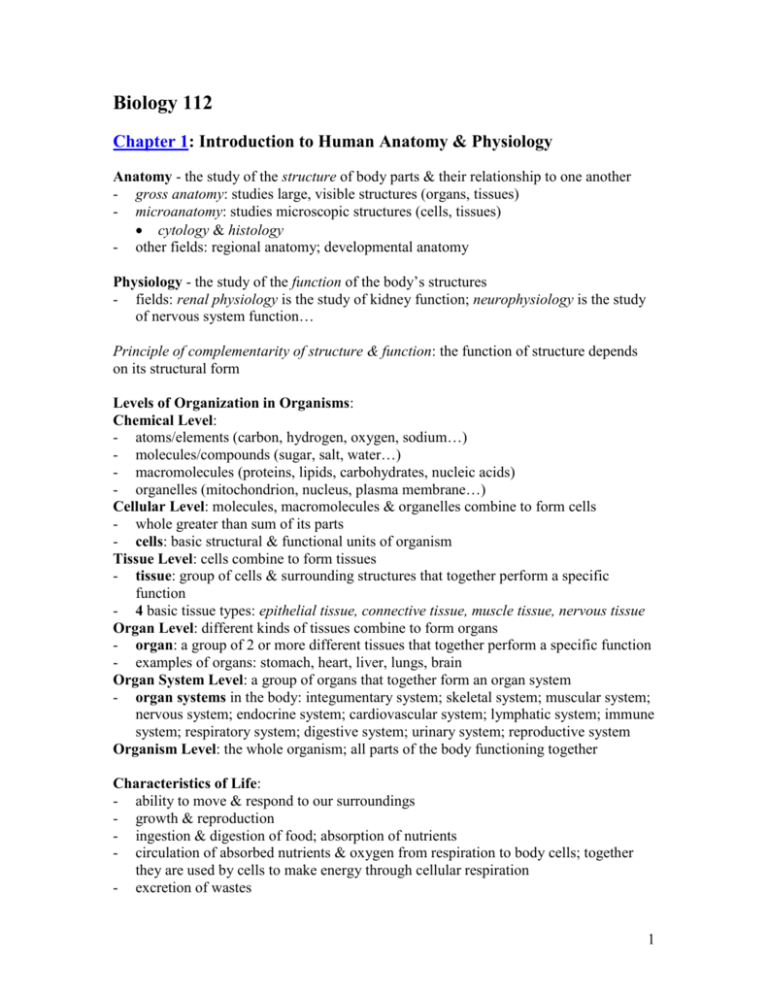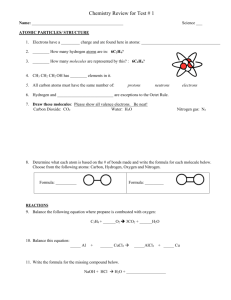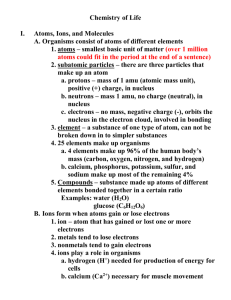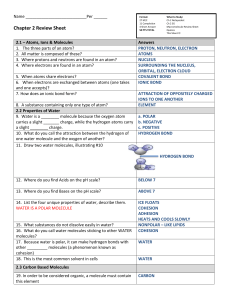Chapter 01
advertisement

Biology 112 Chapter 1: Introduction to Human Anatomy & Physiology Anatomy - the study of the structure of body parts & their relationship to one another - gross anatomy: studies large, visible structures (organs, tissues) - microanatomy: studies microscopic structures (cells, tissues) cytology & histology - other fields: regional anatomy; developmental anatomy Physiology - the study of the function of the body’s structures - fields: renal physiology is the study of kidney function; neurophysiology is the study of nervous system function… Principle of complementarity of structure & function: the function of structure depends on its structural form Levels of Organization in Organisms: Chemical Level: - atoms/elements (carbon, hydrogen, oxygen, sodium…) - molecules/compounds (sugar, salt, water…) - macromolecules (proteins, lipids, carbohydrates, nucleic acids) - organelles (mitochondrion, nucleus, plasma membrane…) Cellular Level: molecules, macromolecules & organelles combine to form cells - whole greater than sum of its parts - cells: basic structural & functional units of organism Tissue Level: cells combine to form tissues - tissue: group of cells & surrounding structures that together perform a specific function - 4 basic tissue types: epithelial tissue, connective tissue, muscle tissue, nervous tissue Organ Level: different kinds of tissues combine to form organs - organ: a group of 2 or more different tissues that together perform a specific function - examples of organs: stomach, heart, liver, lungs, brain Organ System Level: a group of organs that together form an organ system - organ systems in the body: integumentary system; skeletal system; muscular system; nervous system; endocrine system; cardiovascular system; lymphatic system; immune system; respiratory system; digestive system; urinary system; reproductive system Organism Level: the whole organism; all parts of the body functioning together Characteristics of Life: - ability to move & respond to our surroundings - growth & reproduction - ingestion & digestion of food; absorption of nutrients - circulation of absorbed nutrients & oxygen from respiration to body cells; together they are used by cells to make energy through cellular respiration - excretion of wastes 1 - metabolism: all the chemical reactions in the body that break down substances & build them up Requirements of Organisms: - water – most abundant chemical in body; many functions; required for metabolism & transport of substances - nutrients (food) – for energy, structural support, cellular reactions - oxygen – for cellular respiration to create energy, which drives metabolism - heat – to maintain normal body temperature (~98˚F or 37˚C) – helps to maintain normal reaction rates - pressure – normal atmospheric pressure required for proper breathing; normal hydrostatic pressure maintained in blood Homeostasis – the maintenance of internal conditions within normal limits Homeostatic Control Mechanisms: receptor senses changes or stimuli in the environment (alteration in set point for a controlled value) & sends information along an afferent pathway to a control center (central nervous system). The control center determines the appropriate response & sends information along an efferent pathway to an effector that produces a response. Negative Feedback: the product or response shuts off or reduces the level of the original stimulus; the variable then changes in a direction opposite the initial change Examples of negative feedback mechanisms: regulation of body temperature, regulation of blood pressure, the withdrawal reflex, regulation of blood glucose levels by the hormones insulin & glucagons Positive Feedback – the product or response enhances or exaggerates he original stimulus such that the response is continued Examples of positive feedback mechanisms: blood clotting, labor contractions during birth Homeostatic Imbalance – some lack of ability to activate/carry out control mechanisms – age is one factor Know the location of each of the following. Also know the subdivisions where appropriate (for example: the pleural cavity is within the thoracic cavity, which in turn is within the ventral body cavity). Dorsal Body Cavity - Cranial cavity - Vertebral or Spinal cavity Ventral Body Cavity - Thoracic cavity Pleural cavity Mediastinum Pericardial cavity - Abdominopelvic cavity 2 Abdominal cavity Pelvic cavity Other Body Cavities: (smaller cavities... most in the head & open to body exterior) - oral & digestive cavities - nasal cavity - orbital cavities - middle ear cavities - synovial cavities Serous membranes: thin 2-layered membranes with fluid-filled space that covers the viscera within thoracic & abdominal cavities and lines walls of thorax & abdomen - 2 layers: visceral layer: covers & adheres to organs within cavity parietal layer: lines walls of cavity - Pleura: covers lungs within pleural cavities - Pericardium: covers heart within pericardial cavity - Peritoneum: covers abdominal viscera within abdominal cavity Organ Systems: - Integumentary System (chapter 5): skin & accessory organs - Support & Movement Skeletal System (chapter 6) Muscular System (chapter 7) - Integration & Coordination Nervous System (chapter 8) Sense Organs (chapter 9) Endocrine System (chapter 10) - Maintenance of the Body Circulatory System (chapter 12) Lymphatic System (chapter 13) Respiratory System (chapter 14) Digestive System (chapter 15) Urinary System (chapter 16) - Reproduction & Development Reproductive System (chapter 17) Anatomical Terminology: Anatomical Position: standing straight, facing forward with feet slightly apart, arms at sides & palms of the hands facing forward. Know the definitions of & be able to apply: Orientation & Directional Terms: (see textbook table for examples) - superior (cephalic or cranial): above another part or toward the head - inferior (caudal): below another part or toward the feet 3 - anterior (ventral): toward the front of the body posterior (dorsal): toward the back of the body medial: closer to midline lateral: further from midline proximal: nearer to trunk of body, origin or point of attachment (usually limbs) distal: further from trunk of body, origin or point of attachment (usually limbs) superficial: toward or at surface of body deep: away from surface of body Planes of the body: (sections are cuts along body planes) - sagittal plane: vertical plane that divides body or organ into left & right parts midsagittal plane (median plane): divides into equal left & right parts parasagittal plane: divides into unequal left & right parts - frontal (coronal) plane: divides body or organ into anterior & posterior parts - transverse plane: divides body or organ into superior & inferior parts - oblique plane: passes through body or organ at angle between transverse plane & sagittal or frontal plane Abdominopelvic Regions - right hypochondriac region; epigastric region; left hypochondriac region - right lumbar region; umbilical region; left lumbar region - right iliac (inguinal) region; hypogastric region; left iliac (inguinal) region Abdominopelvic Quadrants - right upper quadrant; left upper quadrant - right lower quadrant; left lower quadrant 4 Chapter 2: Chemical Basis of Life Basic Chemistry: Matter: anything that has mass & takes up space - matter is composed of elements - states of matter: solid, liquid or gas Elements are composed of atoms Atoms are composed of subatomic particles: - protons (+ charge) - neutrons (no charge) - electrons (- charge) The atomic number of an atom = the number of protons in its nucleus - the periodic table is grouped according to atomic number (Hydrogen (H) has an atomic number of 1, Helium (He) has an atomic number of 2…) The atomic mass (mass number) of an atom is the number of protons + the number of neutrons in its nucleus (the mass of electrons is negligible) - Hydrogen (H) has a mass number of 1 (no neutrons), Helium (He) has a mass number of 4… - the atomic weight of an element is the average of the relative weights of all the isotopes of that element (the atomic weight of Hydrogen is 1.008). Isotopes are atoms of an element that have the same number of protons (atomic number) but different numbers of neutrons. (examples: 12C, 13C, 14C) - radioactive isotopes are unstable and spontaneously decay into more stable forms Chemical Bonds: Electrons of an atom differ in amount of potential (stored) energy - electrons closest to the nucleus have the least potential energy (nonbonding electrons) - electrons farthest from the nucleus have the greatest potential energy (valence or bonding electrons) - first energy level can contain a maximum of 2 bonding electrons second energy level, and all additional energy levels, can contain a maximum of 8 bonding electrons octet rule: except for the first energy level, the outermost energy level is most stable when it has 8 bonding electrons (the first energy level is most stable with its maximum of 2 bonding electrons) Bonding: Ionic Bonding: transfer of electrons from one atom to another - results in ions: charged particles resulting from charge imbalance (greater or fewer electrons than protons) due to electron transfer - Examples: NaCl, MgCl2, Na2O 5 - chemical formulas of compounds based on # of valence electrons (example: from above: MgCl2, Mg has 2 valence electrons to donate, while Cl can only accept 1, so two Cl atoms are needed to accept the 2 valence electrons donated by one Mg atom) Covalent bonding: sharing of electrons between 2 or more atoms - each atom acquires an octet of valence electrons (electrons in outermost shell). Examples: CH4, O2, H2, C6H12O6 - water (H2O) is formed by a polar covalent bond (unequal sharing of electrons) Hydrogen Bonding: - bond between a slightly positive hydrogen atom of one molecule, and a slightly negative atom (usually oxygen or nitrogen)of the same or another molecule - weak bonding compared to ionic and covalent bonding, but many bonds increases strength - good example is water molecules Molecules: 2 or more atoms held together by chemical bonds - when 2 or more different atoms bind, they form one molecule of a compound Chemical Reactions: Synthesis (combination) reaction: atoms or molecules combine to form a larger molecule - metabolic synthesis reactions are termed anabolic reactions Decomposition reaction: a molecule is broken down into smaller molecules, or its constituent atoms - metabolic decomposition reactions are termed catabolic reactions Exchange (displacement) reaction: components of the reactant molecules change partners, resulting in different molecules as products - example: neutralization reactions (strong acid + strong base -> salt + water) HCl + NaOH -> NaCl + H2O All chemical reactions are, in theory, reversible… however, many biological reactions show little or no tendency to go in the reverse direction - chemical equilibrium: neither the forward nor the reverse reaction is reversible (for each product molecule formed, one product molecule breaks down) - catalysts: increase rate of chemical reactions without themselves being changed in the reaction… enzymes are biological catalysts Electrolytes: substances that ionize, or break apart & release ions, when put into water - Acid: molecules that release hydrogen ions (H+) when dissolved in water - acids are hydrogen ion (proton) donors - Base: molecules that release hydroxide (OH-) ions , or increase the number of hydroxide ions available, when dissolved in water 6 - bases are hydrogen ion (proton) acceptors Salt: ionically-bonded molecule that dissociates into cations & anions in solution - in the body, salts are electrolytes that conduct electricity (important for nerve & muscle cells) & provide essential chemical elements in body fluids (blood, lymph & interstitial fluids) pH scale (power of hydrogen): indicates acidity or basicity of solution - ranges from 0 (strong acid) to 14 (strong base) - pH < 7 is acidic; pH > 7 is basic; pH = 7 is neutral - water ionizes to release equal numbers of hydrogen ions and hydroxide ions (neutral) Buffers: maintain stable pH of solution (resist changes in pH) - Buffers have acidic and basic components, and can take up excess hydrogen or hydroxide ions Chemical Constituents of Cells Inorganic Molecules: molecules (usually ionic-bonding) that do not contain carbon and hydrogen (e.g.: salts, strong acids and bases, metal compounds) - water - oxygen - carbon dioxide - salts Organic Molecules: carbon-based molecules - carbon atoms are bonded mainly to atoms of hydrogen, oxygen, and nitrogen, as well as some other atoms - always contain carbon and hydrogen - always covalent-bonding Organic Substances: Carbohydrates: (contain carbon, hydrogen, and oxygen atoms) Monosaccharides: simple sugars with a backbone of 3 to 7 carbon atoms - glucose (in the blood of animals) and Fructose (in fruits) are 6-carbon sugars - ribose is a 5-carbon sugar found in RNA (in DNA, the sugar is deoxyribose) Disaccharides: 2 monosaccharides joined by condensation - maltose (in the digestive tract), lactose (in milk), & sucrose (in fruits & vegetables) Polysaccharides: - glycogen is a highly branched polymer of glucose, and is the storage form of carbohydrates in animal cells (stored in liver cells) - starch & cellulose are polysaccharides in plants Lipids: In the form of neutral fats (fats or oils) 7 one triglyceride = glycerol + 3 fatty acids - glycerol has 3 carbon atoms and 3 hydroxyl groups - fatty acids have a long hydrocarbon (carbon + hydrogen) chain with a carboxylic acid group at one end; fatty acids are generally hydrophobic - saturated fatty acids: each carbon atom in the fatty acid molecules have the maximum number of bonded hydrogen atoms (each carbon is saturated with hydrogen atoms) - unsaturated fatty acids: one or more carbon atoms in the fatty acid molecule has less than the maximum number of bonded hydrogen atoms In animal cells, neutral fats are in the form of fats In plant cells, neutral fats are in the form of oils Phospholipids = Glycerol + 2 fatty acids + 1 polar (phosphate-containing) head group - allows molecules to have hydrophobic end (2 fatty acids) and hydrophilic (phosphate) end - these molecules are the subunits of biological membranes in cells (e.g.: plasma membrane) Steroids are composed of 4 fused carbon rings plus some variable functional side group - cholesterol is a structural component of the plasma membrane in animals, and is used in the synthesis of vitamin D and bile salts - cholesterol is modified to produce several other types of steroids - steroids function as hormones in animal cells - accumulation of large amounts of these bulky molecules in animals can lead to reduced blood flow and hypertension (high blood pressure) Proteins: Proteins are composed of chains of amino acid monomers - There are 20+ different amino acids in cells of living organisms - Amino acids have a basic core structure plus an additional functional side chain - Each amino acid has a central carbon bonded to an amino group, a carboxylic acid group, a hydrogen atom, and the remaining side chain (R group); it is the R group that differs in different amino acids - R groups can be nonpolar & hydrophobic, or polar & hydrophilic, depending on the atoms present - some proteins function as enzymes – organic catalysts that speed up chemical reactions Polypeptide: a chain of many amino acids joined by peptide bonds - a protein can be composed of one or several polypeptide chains - condensation of two amino acids in a growing polypeptide chain results in the formation of a peptide bond - hydrolysis of peptide bonds occurs between specific amino acids in a protein by the activity of specific enzymes (e.g.: pepsin) Protein Structure - primary structure: the sequence of amino acids in a polypeptide chain 8 - - - secondary structure: the formation of discrete structures (alpha helices or beta pleated sheets) involving several amino acids within a polypeptide chain (held together by hydrogen bonds) tertiary structure: the conformation of the polypeptide chain following interactions of regions of secondary structure o if the protein only consists of 1 polypeptide, this is the final structure of the protein quaternary structure: structure following interaction and bonding between two or more (the same or different) polypeptide chains o hydrogen or ionic bonding between polypeptide chains Denaturation: disruption of specific 3D structure of a protein by increasing temperature (boiling) or changing pH - may be reversible (remember: the structure of a given polypeptide is specific as well as consistent and reproducible) Nucleic Acids: Nucleic Acids are polymers of nucleotide monomers - a nucleotide = a pentose sugar + a phosphate + a nitrogenous (nitrogen-containing) base - In RNA (Ribonucleic Acid), the pentose is ribose - In DNA (Deoxyribonucleic Acid), the pentose is deoxyribose (missing a hydroxyl group at carbon # 2 relative to ribose) DNA: DNA is the genetic material of the cell (inherited from parents) - composed of a sequence of four different nucleotides - the 4 nucleotide subunits of DNA are named after the nitrogenous base each contains; the 4 bases are : adenine (A) cytosine (C) guanine (G) thymine (T) - DNA forms a double-helical structure (DNA is double-stranded), in which two chains bond together; the sugar and phosphate groups are on the outside, and the nitrogenous bases interact by hydrogen bonding in the middle of the double helix - the 2 strands (nucleotide chains) of the double helix are complementary: RNA: - RNA is synthesized from 1 strand of DNA - RNA does not form a double helix (no pairing of complementary bases between 2 strands); RNA is single-stranded - RNA also uses 4 nucleotide subunits; however, uracil (U) replaces thymine in RNA - major forms of RNA in cells are: messenger RNA (mRNA), transfer RNA (tRNA) & ribosomal RNA (rRNA) - ATP is an RNA nucleotide used for energy in cells Genes in DNA code for polypeptides: the sequence of bases in DNA serves as a code for directing the sequence of bases in mRNA, and then the sequence of amino acids in a protein 9









